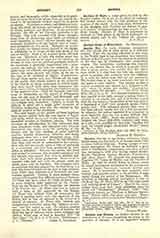

Ancona and Umana, an Italian diocese in the Archdiocese of Ancona, comprising ten towns in the province of Ancona. It is an important seaport town, favorable for commerce between the East and Italy, across the Adriatic. Ancona must have had a Christian community within its walls at a very early date. Excavations made in the village of Varano, near Ancona, have brought to light a sepulchral stone with a Christian inscription. The character of the writing of the epitaph shows that it belongs to the end of the third century, and we are justified in believing that the church at Ancona did not possess catacombs, but an open burial place. For the purpose of proving the existence of a well-organized Christian community before the time of Constantine, Harnack [Die Mission, etc., (Leipzig, 1902), 501, 502] advances arguments that seem perfectly legitimate. Eusebius says (VI, 43) that the Roman Bishop Cornelius, in the year 250, held a synod of sixty Italian bishops against Novatian. It may be assumed that the jurisdiction of Rome as a metropolitan see, about the year 250, embraced not less than two hundred bishoprics, since all the bishops of a given territory did not attend the synods. It follows that Christians were found in all the more important cities, amongst which, of course, was Ancona. The city is under the protection of two saints, Primianus and Cyriacus, evidently very ancient, but their rank and the time they flourished are uncertain. In the year 462, Mark of Ancona came to the synod held under Pope Hilary; and in 465, to the new synod convoked by the same Pope came Philippus Numanatm. The two sees were united in 1422, at the time of Pope Martin V. From an archaeological point of view, besides the place of sepulture mentioned above, the cubiculum of the veteran Flavius Eventius, with a singular inscription and a magnificent mosaic of the fourth century, is worthy of mention, as is also the sarcophagus of Flavius Gorgonius, comes privatarum largitionum (count of the emperor’s private largess), of the same century. There is also an “Evangelium Sancti Marcellini ‘, in uncial characters, of the seventh century, preserved in the Chapter library. The Cathedral of Ancona, dedicated to St. Cyriacus, and standing in the highest part of the city, is in a style of architecture that has felt the direct influence of Oriental art. It was finished in the eleventh century and has a cupola with a quadrangular base like St. Fosca on the Venetian lagoons and St. Anthony at Padua.
Ancona contains 37 parishes; 85 churches, chapels, and oratories; 101 secular priests; 30 seminarians; 15 regular clergy; 8 lay brothers; 70 religious (women); 50 confraternities; 4 schools for boys (400 pupils); 5 schools for girls (250 pupils). Population 81,662.
ERNESTO BUONAIUTI

